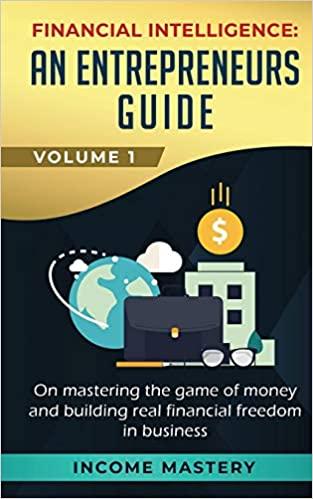Answered step by step
Verified Expert Solution
Question
1 Approved Answer
. Please Give: Examine the case study (Pepsi Co) given in the module section and submit your analysis. Shareholders' Equity at PepsiCo Having just finished

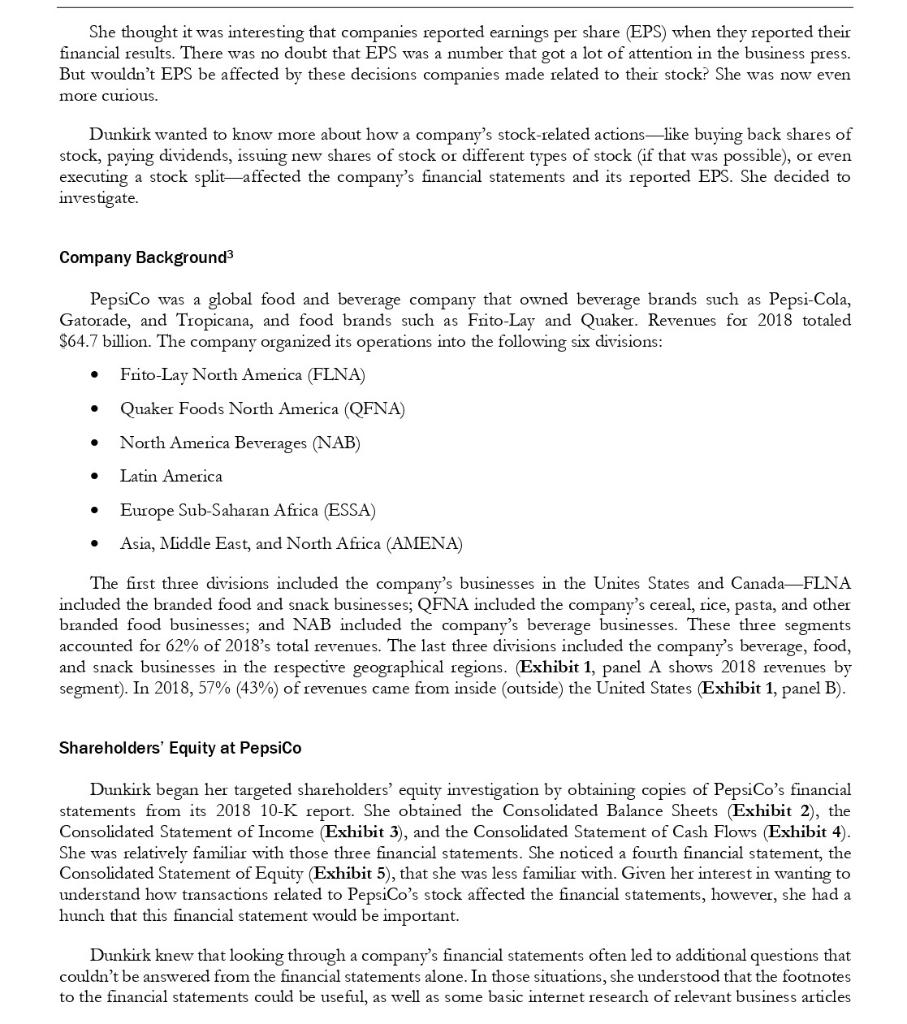
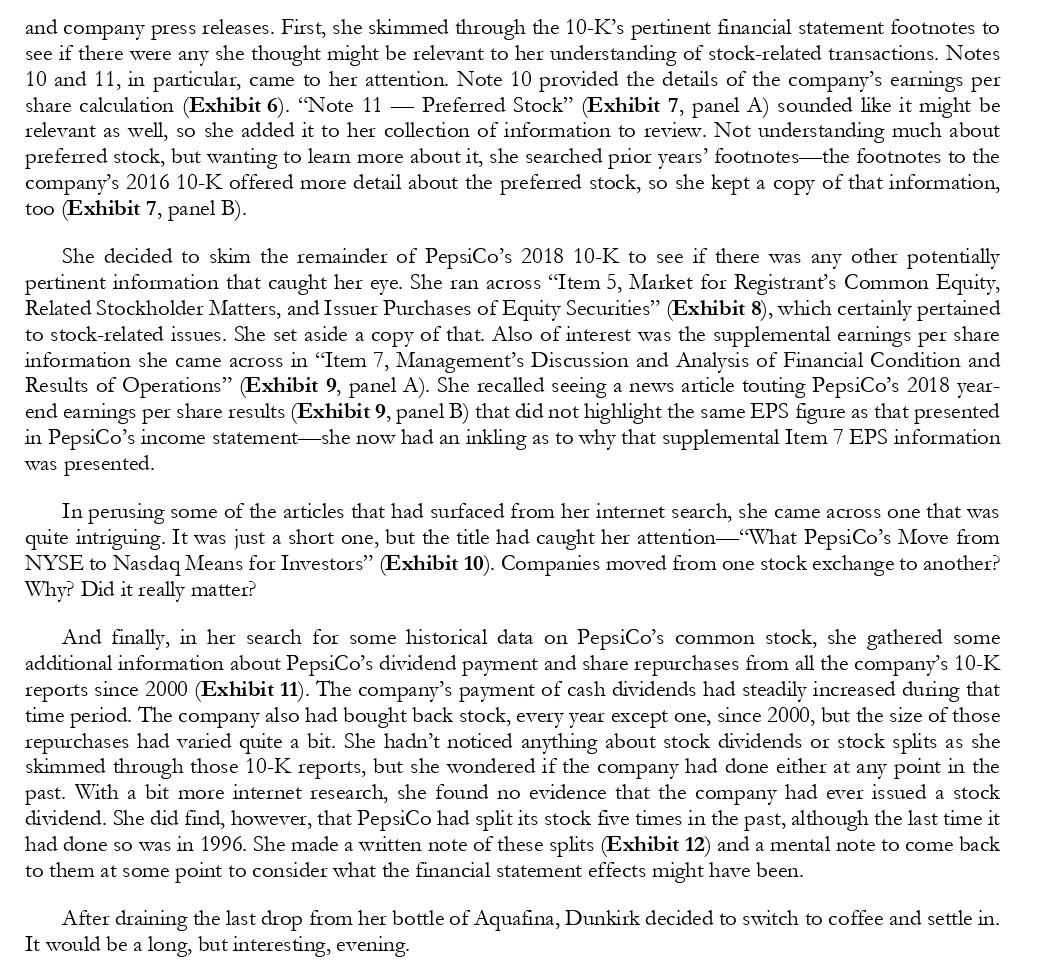
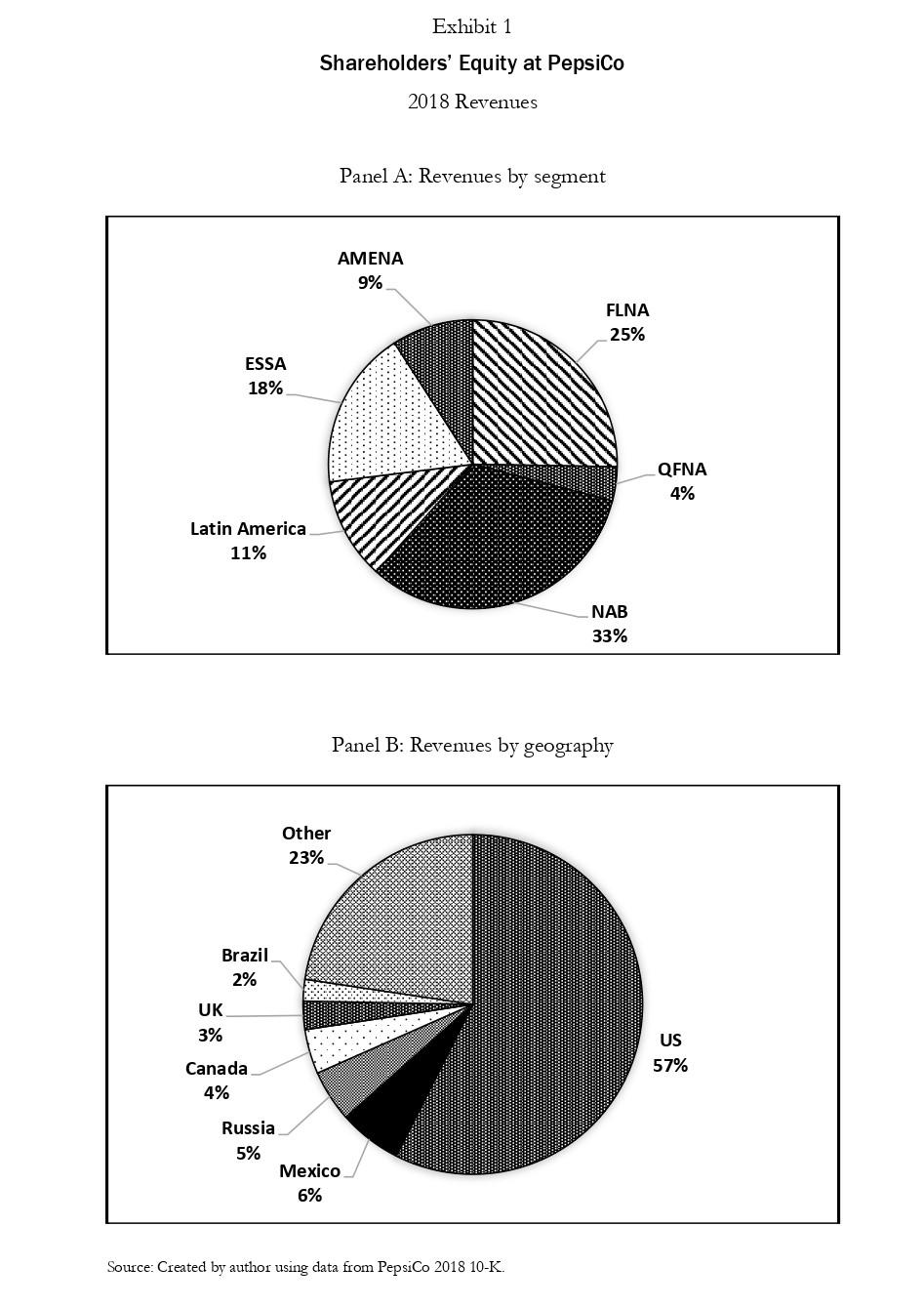
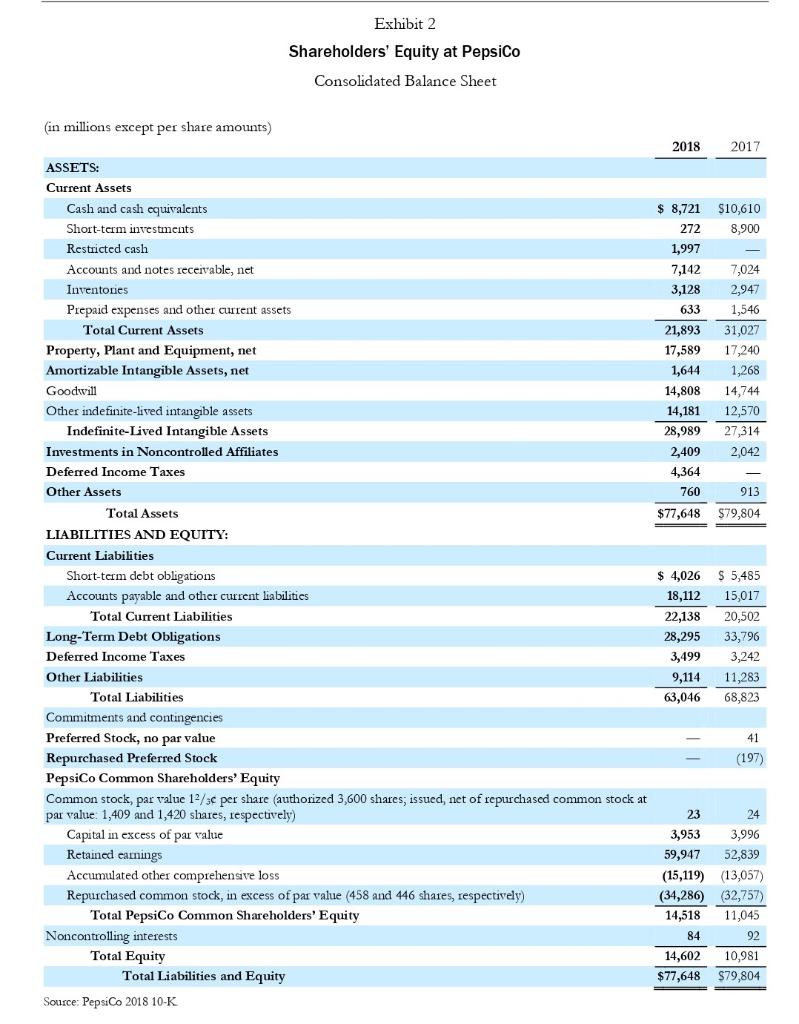

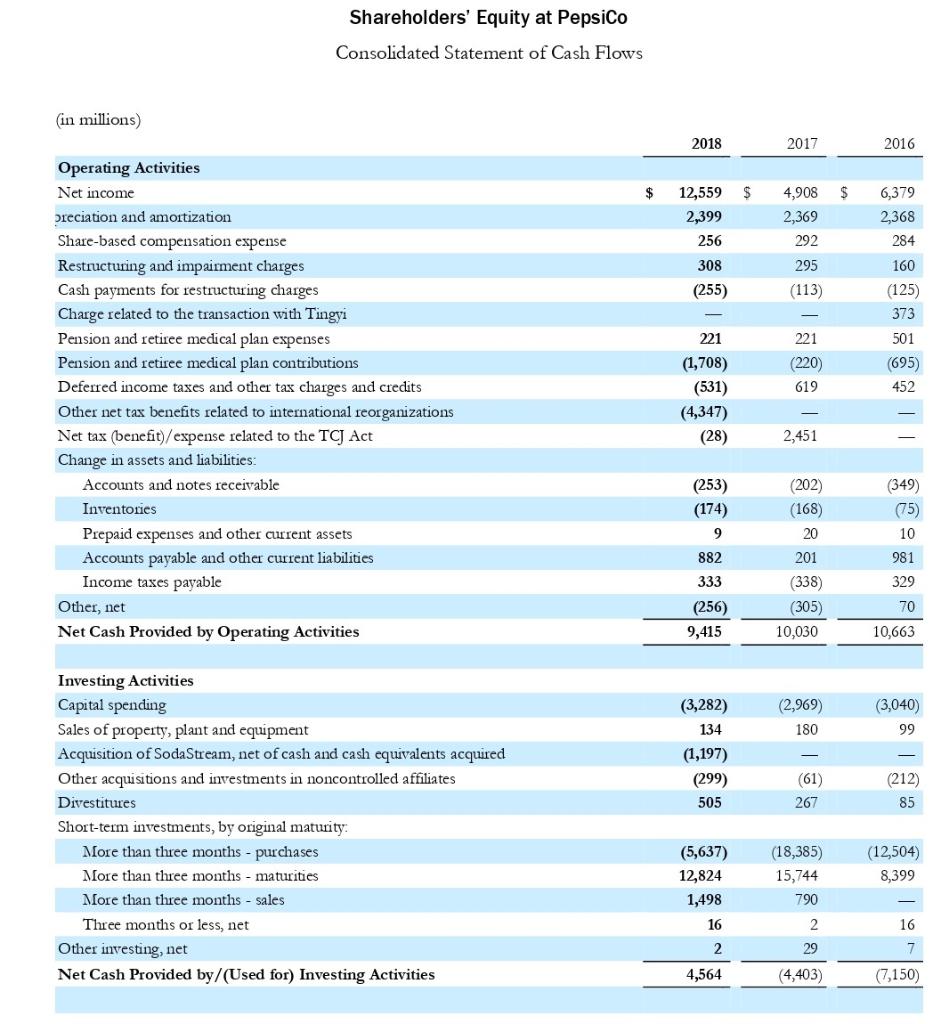

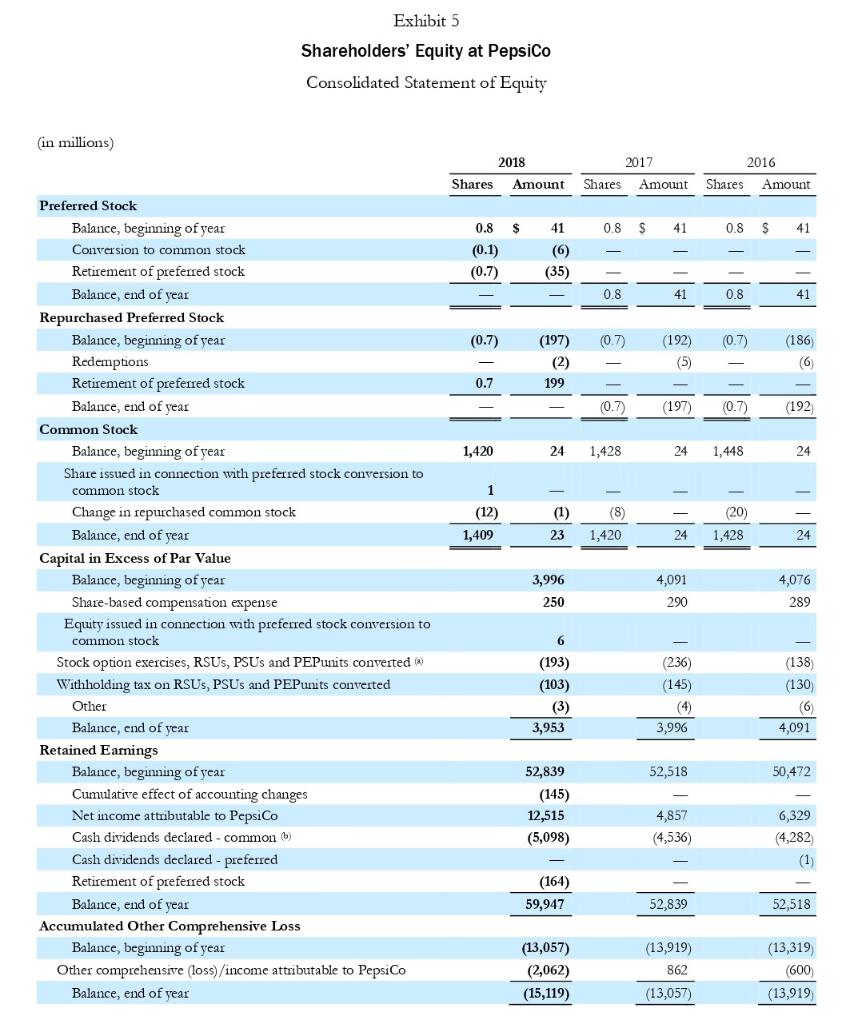
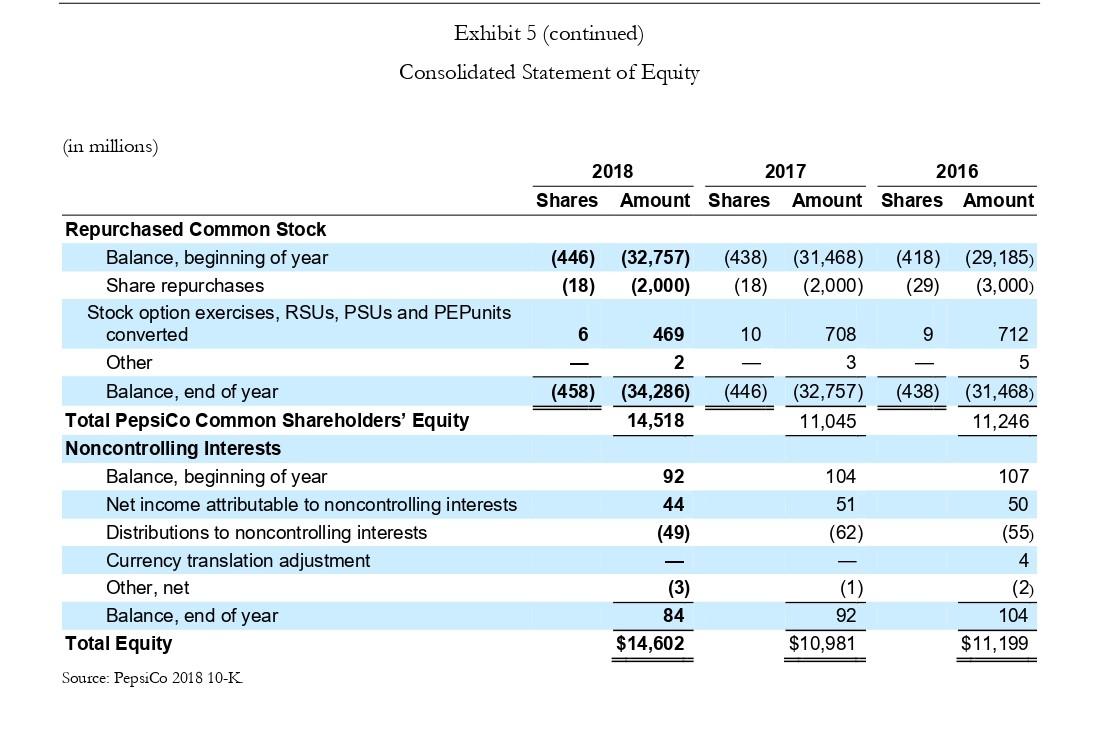
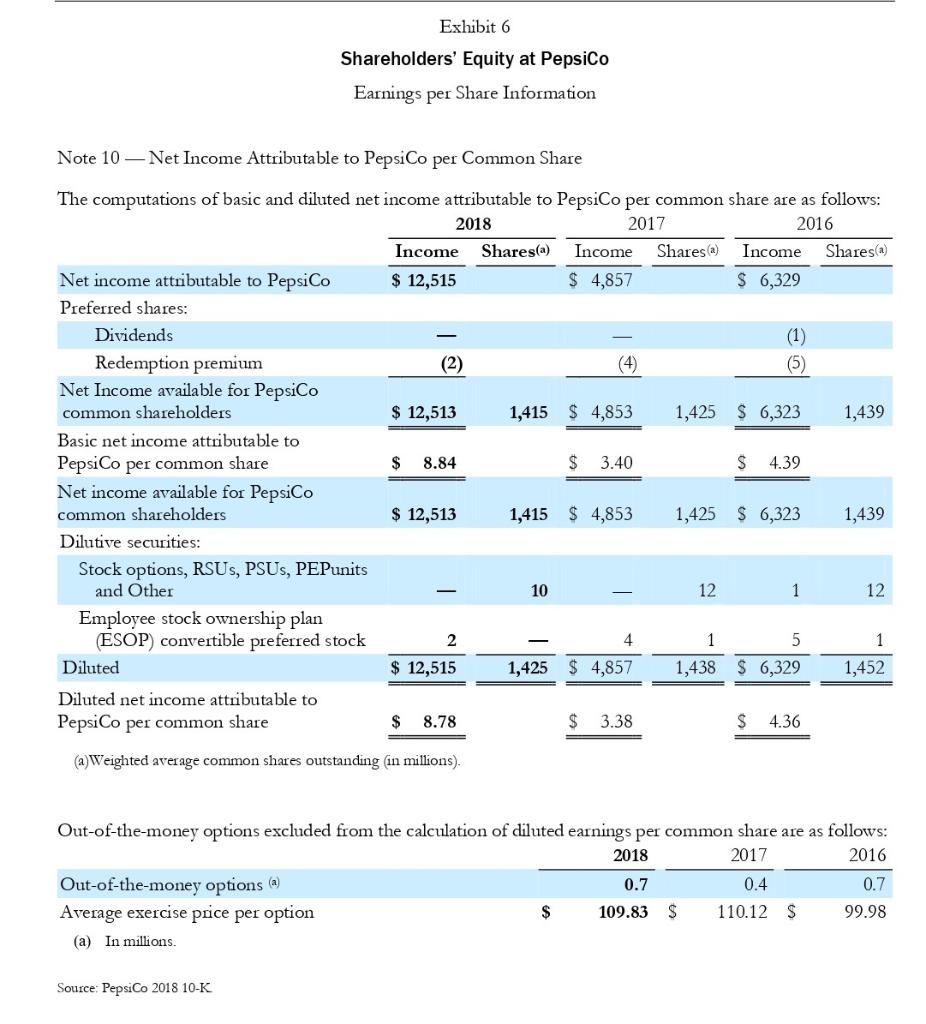
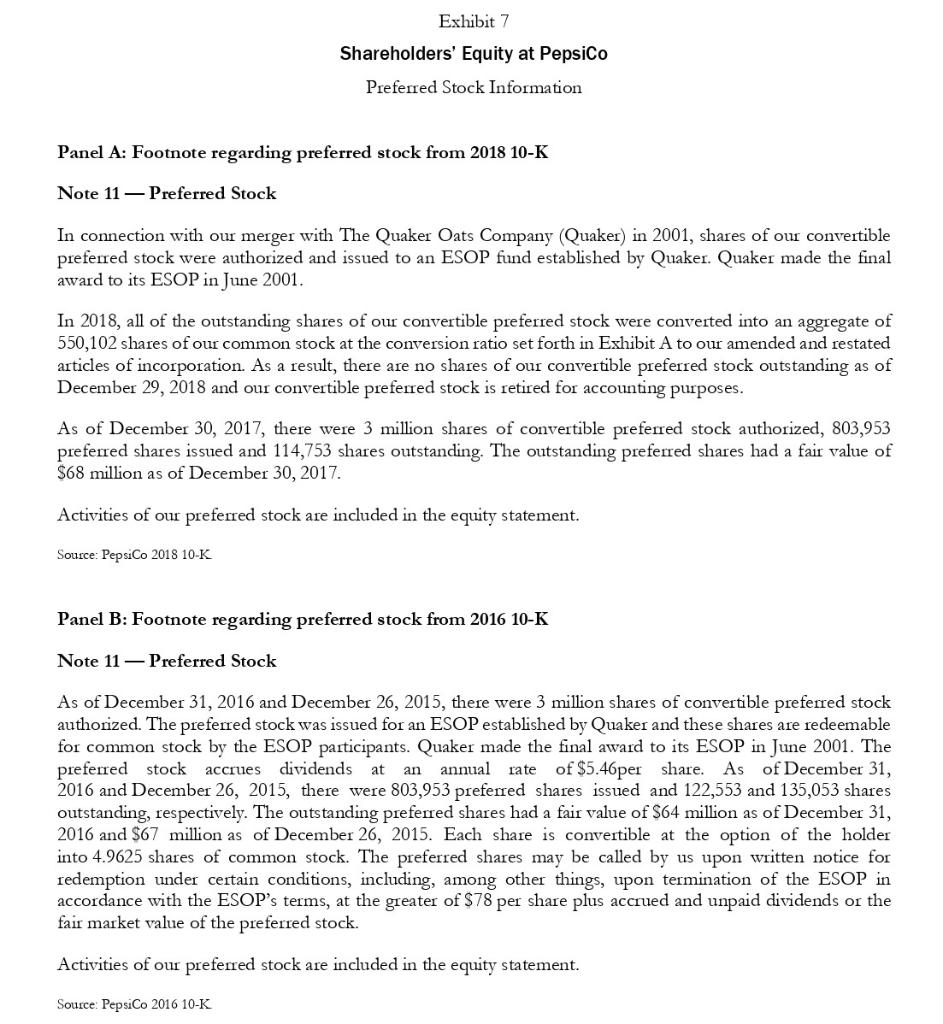
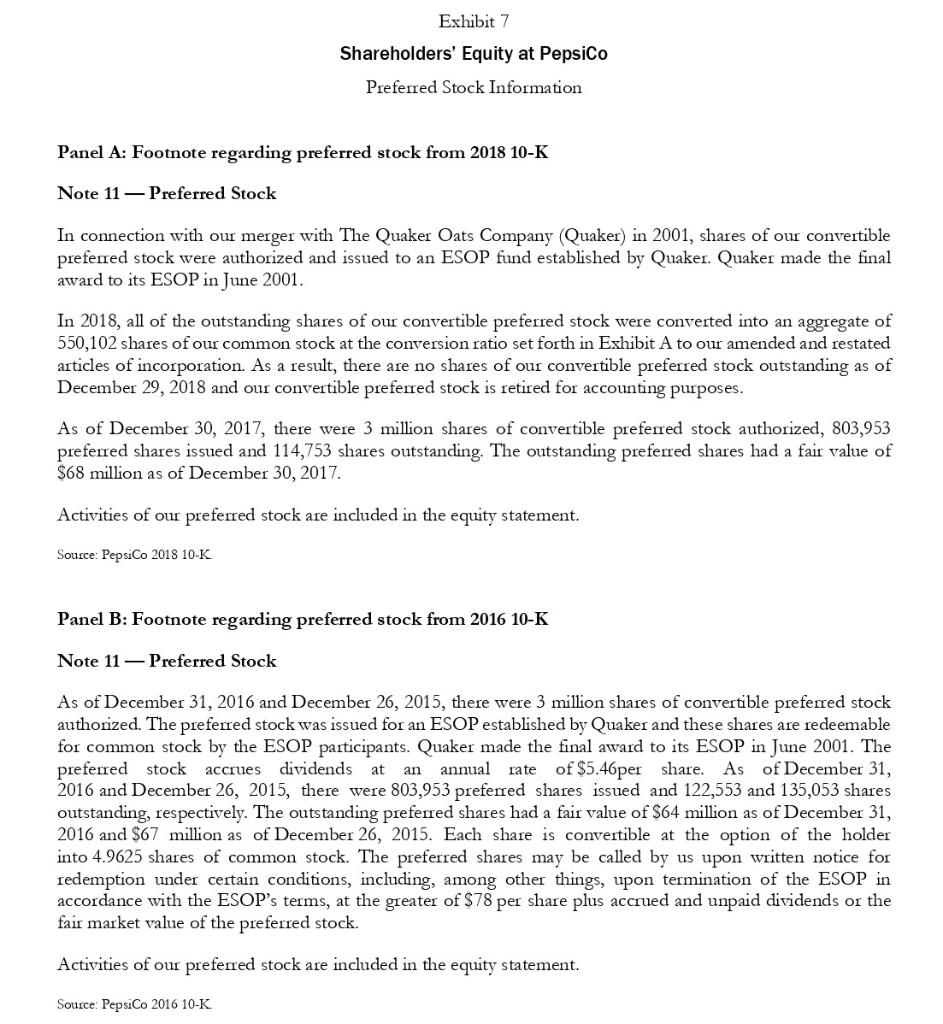
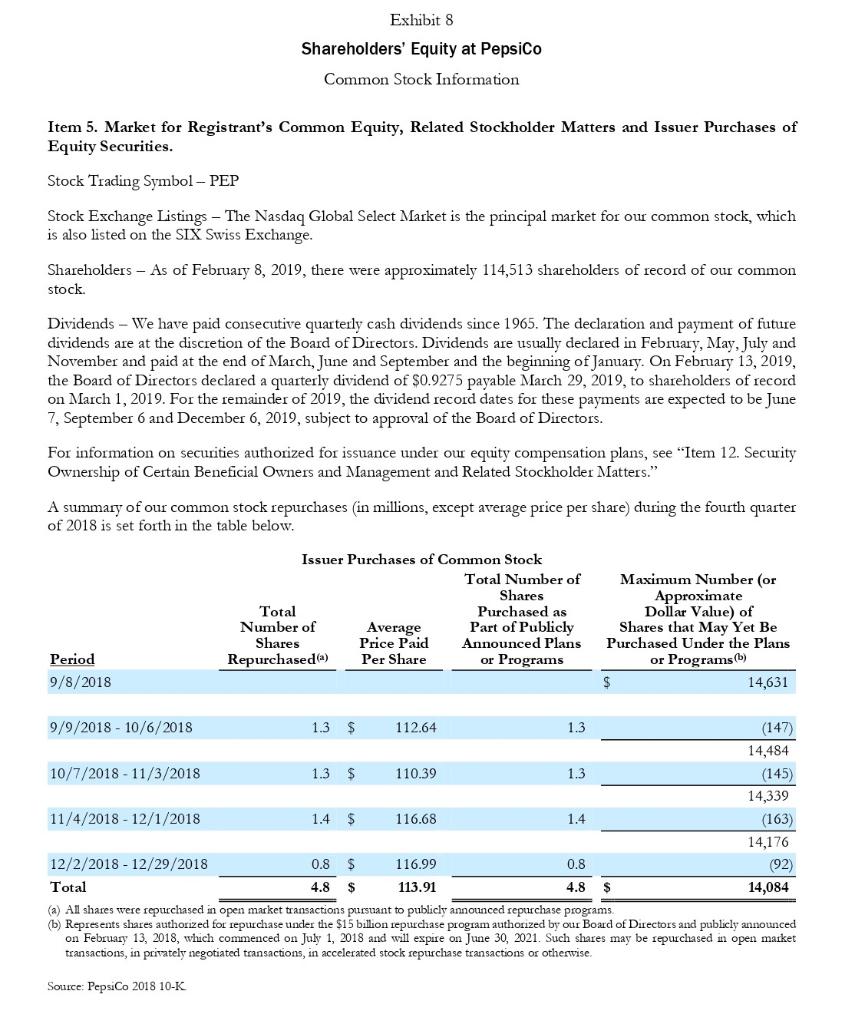
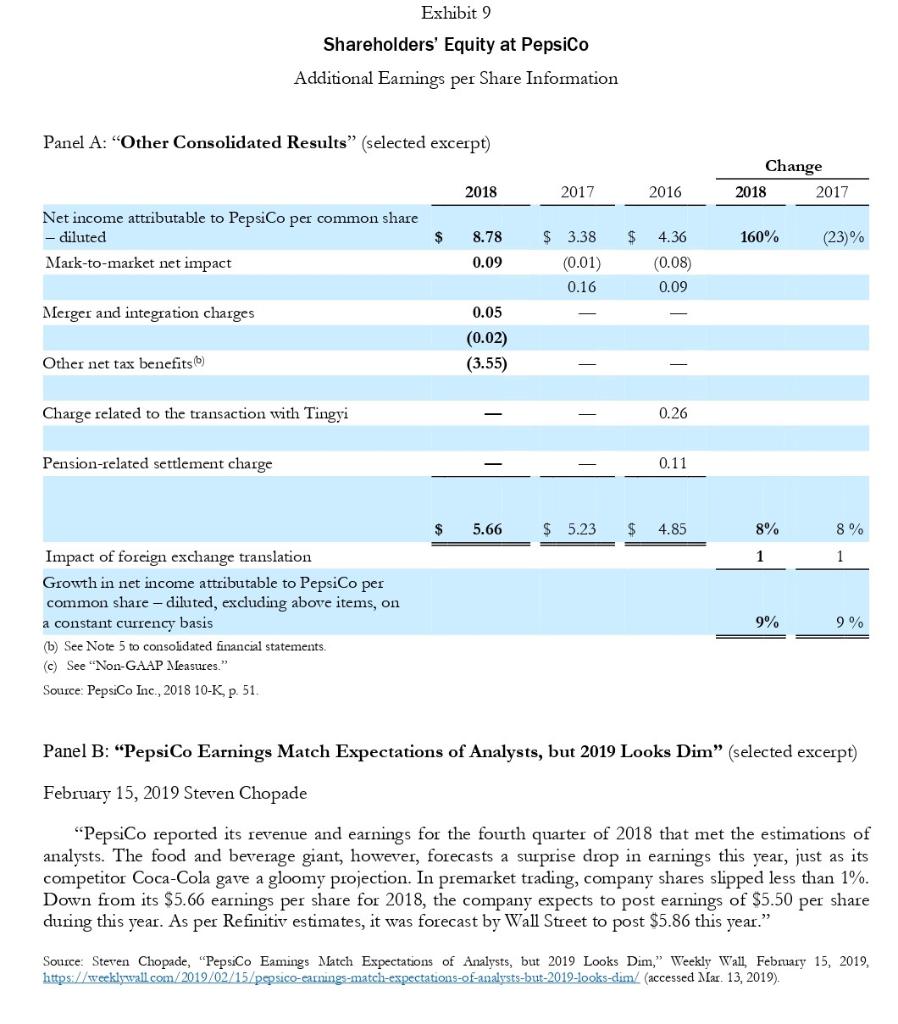
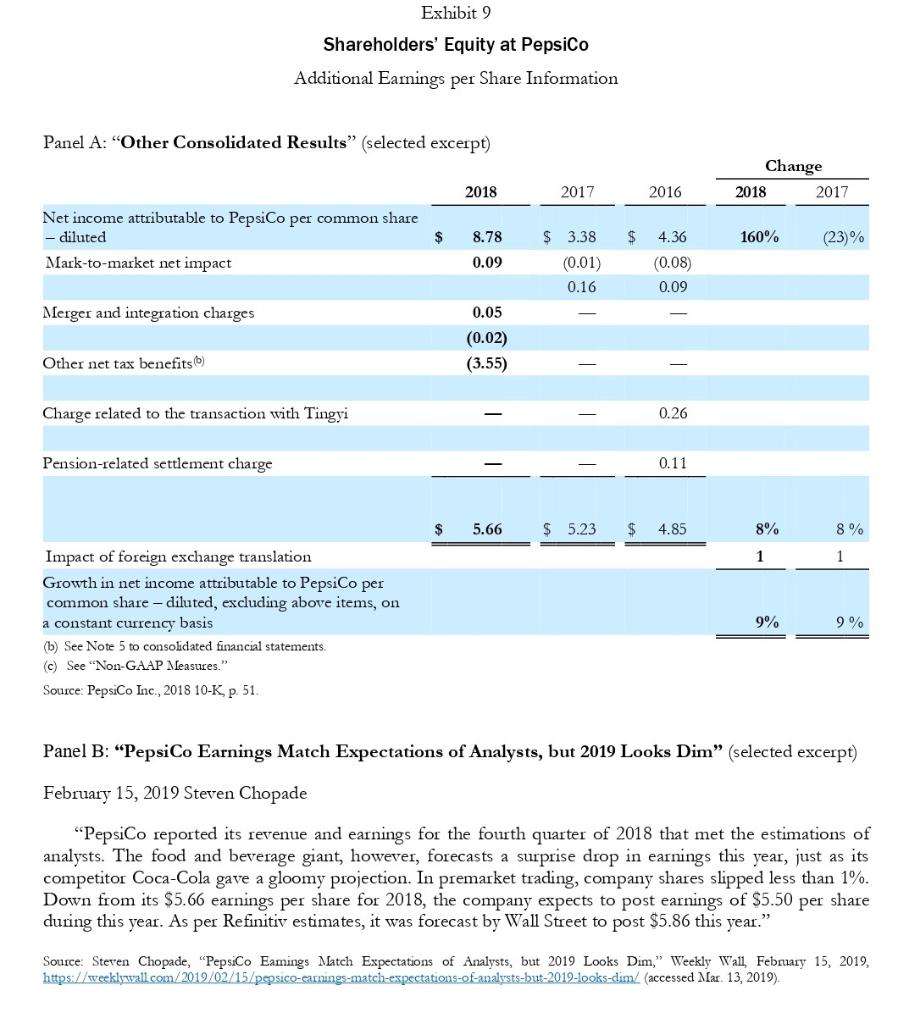
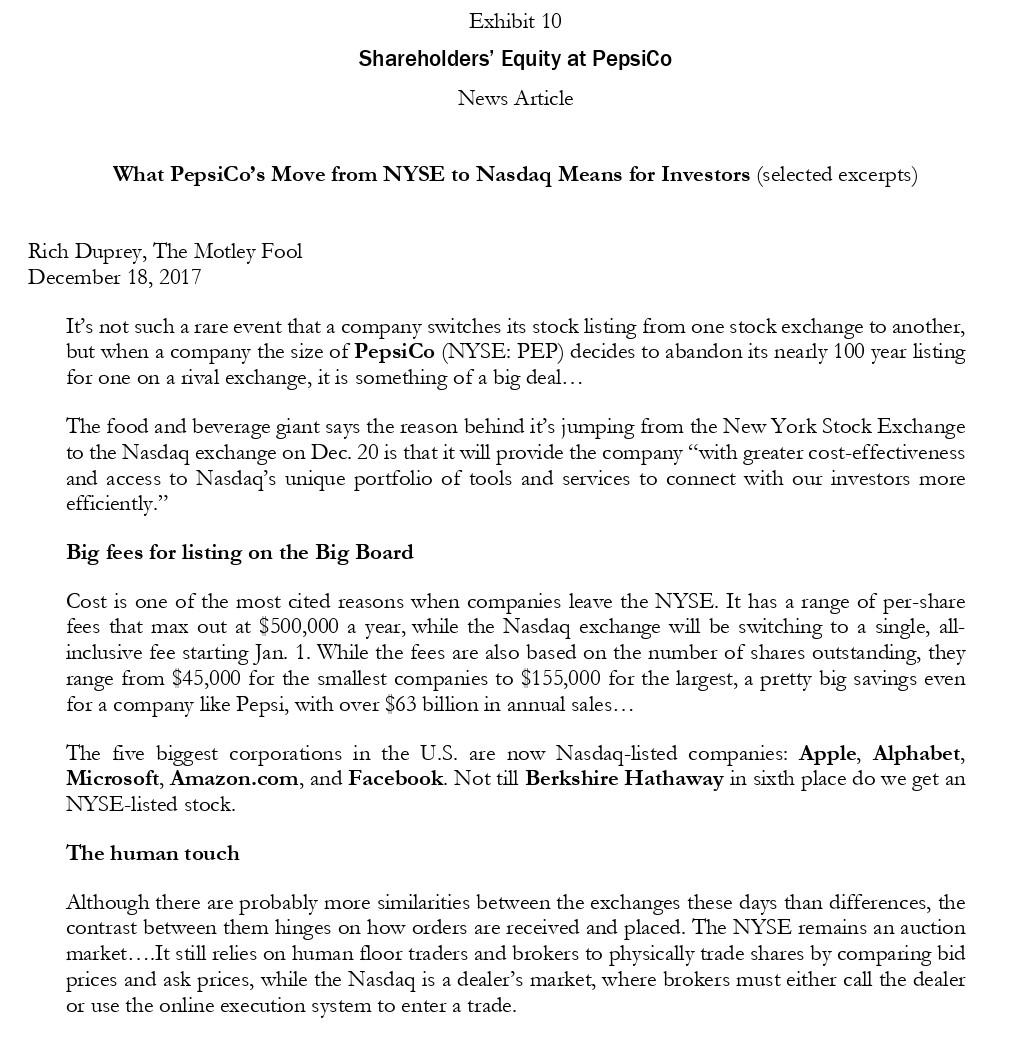
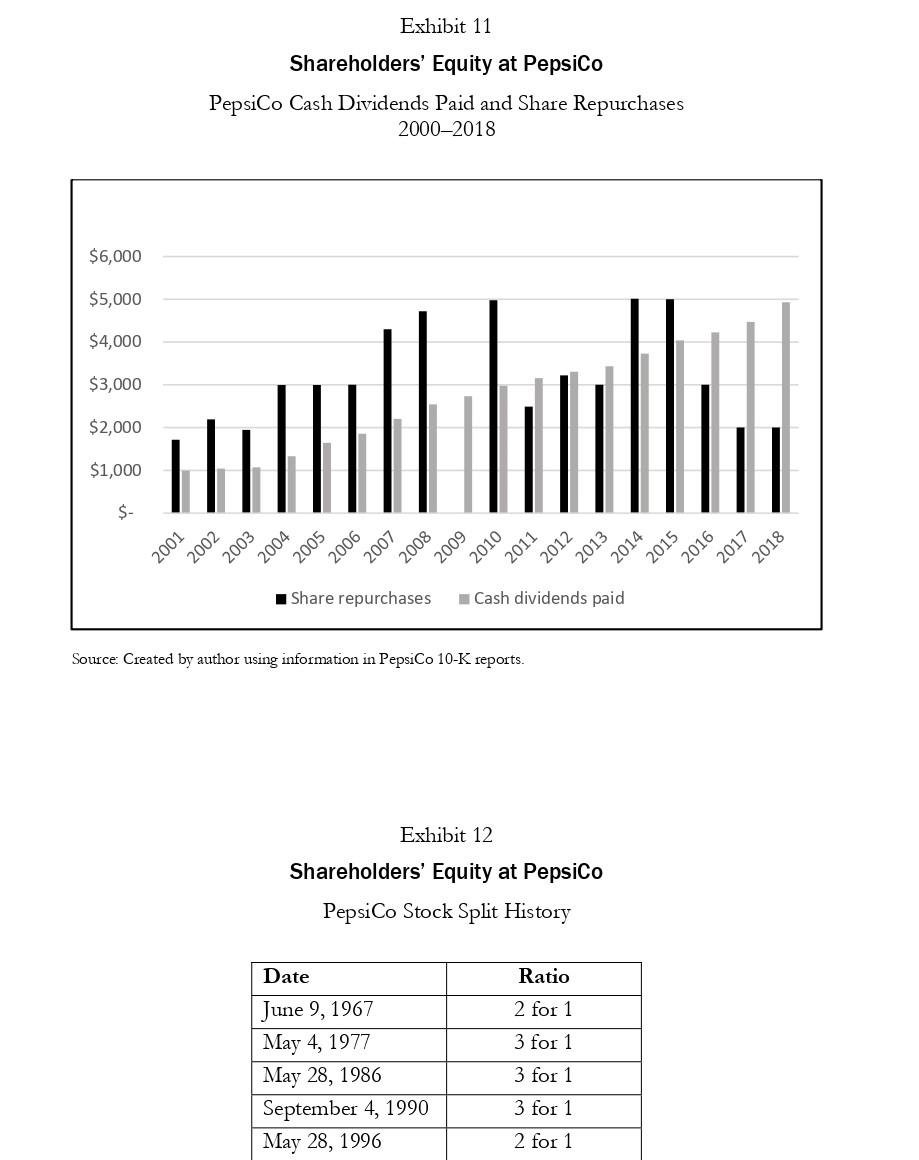
.
Please Give:
Examine the case study (Pepsi Co) given in the module section and submit your analysis.
Shareholders' Equity at PepsiCo Having just finished her afternoon run, Joan Dunkirk opened a bottle of Aquafina and took a sip to quench her thirst as she sat down to scan the financial news online. She noticed that PepsiCo had released a summary of 2018 results. She skimmed the summary and noted PepsiCo's expectations about dividends and share repurchases for 2019: The Company today announced a 3 percent increase in its annualized dividend per share to \$3.82 from $3.71 per share, effective with the dividend expected to be paid in June 2019. This represents the Company's 47 th consecutive annual dividend per share increase...For 2019, the Company expects...total cash returns to sharebolders of approximately $8 billion, comprised of dividends of approximately $5 billion and share repurchases of approximately $3 billion. 1 Dunkirk wasn't quite sure why companies would buy back their own stock. She bought stock when it was a good deal, making money on it by either collecting the dividends the company paid and/or holding onto the stock while the stock price increased and then selling it later. But she wasn't sure whether, or how, her logic translated to management's thinking when they decided to buy back a company's stock. Setting her bottle of water on the table, she stared at it. Something caught her eye; something she had never noticed before. "Copyright PepsiCo 2018." There it was, right below the main label. Dunkirk remembered her surprise when she first discovered that the company didn't just make Pepsi and Diet Pepsi. It made so many of the snacks and drinks she had grown up enjoying-Lays potato chips, Fritos corn chips, Quaker oatmeal, Gatorade sports drinks, Tropicana orange juice, Sabre hummus, and many, many more. And now, she realized that the company also made Aquafina. Surely the company's stock was a good investment with all those popular brand names in its portfolio. Perhaps the company was buying back its own stock to fuel future stock appreciation. She didn't know for sure. According to PepsiCo's summary announcement, share repurchases and payment of dividends were two ways companies could provide cash returns to shareholders. But what about stock dividends as opposed to cash dividends? And what about stock splits? Both stock dividends and stock splits increased the number of shares of stock a shareholder owned, so it seemed they would provide something of value to shareholders as well. But there was no mention of either of those in PepsiCo's summary of 2018 results. She continued skimming the summary of 2018 results: Reported net revenue increased 2 perrent.... Reported EPS was $8.782 She thought it was interesting that companies reported earnings per share (EPS) when they reported their financial results. There was no doubt that EPS was a number that got a lot of attention in the business press. But wouldn't EPS be affected by these decisions companies made related to their stock? She was now even more curious. Dunkirk wanted to know more about how a company's stock-related actions-like buying back shares of stock, paying dividends, issuing new shares of stock or different types of stock (if that was possible), or even executing a stock splitaffected the company's financial statements and its reported EPS. She decided to investigate. Company Background 3 PepsiCo was a global food and beverage company that owned beverage brands such as Pepsi-Cola, Gatorade, and Tropicana, and food brands such as Frito-Lay and Quaker. Revenues for 2018 totaled $64.7 billion. The company organized its operations into the following six divisions: - Frito-Lay North America (FLNA) - Quaker Foods North America (QFNA) - North America Beverages (NAB) - Latin America - Europe Sub-Saharan Africa (ESSA) - Asia, Middle East, and North Africa (AMENA) The first three divisions included the company's businesses in the Unites States and Canada-FLNA included the branded food and snack businesses; QFNA included the company's cereal, rice, pasta, and other branded food businesses; and NAB included the company's beverage businesses. These three segments accounted for 62% of 2018's total revenues. The last three divisions included the company's beverage, food, and snack businesses in the respective geographical regions. (Exhibit 1, panel A shows 2018 revenues by segment). In 2018, 57\% (43\%) of revenues came from inside (outside) the United States (Exhibit 1, panel B). Shareholders' Equity at PepsiCo Dunkirk began her targeted shareholders' equity investigation by obtaining copies of PepsiCo's financial statements from its 2018 10-K report. She obtained the Consolidated Balance Sheets (Exhibit 2), the Consolidated Statement of Income (Exhibit 3), and the Consolidated Statement of Cash Flows (Exhibit 4). She was relatively familiar with those three financial statements. She noticed a fourth financial statement, the Consolidated Statement of Equity (Exhibit 5), that she was less familiar with. Given her interest in wanting to understand how transactions related to PepsiCo's stock affected the financial statements, however, she had a hunch that this financial statement would be important. Dunkirk knew that looking through a company's financial statements often led to additional questions that couldn't be answered from the financial statements alone. In those situations, she understood that the footnotes to the financial statements could be useful, as well as some basic internet research of relevant business articles and company press releases. First, she skimmed through the 10-K's pertinent financial statement footnotes to see if there were any she thought might be relevant to her understanding of stock-related transactions. Notes 10 and 11, in particular, came to her attention. Note 10 provided the details of the company's earnings per share calculation (Exhibit 6). "Note 11 - Preferred Stock" (Exhibit 7, panel A) sounded like it might be relevant as well, so she added it to her collection of information to review. Not understanding much about preferred stock, but wanting to learn more about it, she searched prior years' footnotes-the footnotes to the company's 2016 10-K offered more detail about the preferred stock, so she kept a copy of that information, too (Exhibit 7, panel B). She decided to skim the remainder of PepsiCo's 2018 10-K to see if there was any other potentially pertinent information that caught her eye. She ran across "Item 5, Market for Registrant's Common Equity, Related Stockholder Matters, and Issuer Purchases of Equity Securities" (Exhibit 8), which certainly pertained to stock-related issues. She set aside a copy of that. Also of interest was the supplemental earnings per share information she came across in "Item 7, Management's Discussion and Analysis of Financial Condition and Results of Operations" (Exhibit 9, panel A). She recalled seeing a news article touting PepsiCo's 2018 yearend earnings per share results (Exhibit 9, panel B) that did not highlight the same EPS figure as that presented in PepsiCo's income statement-she now had an inkling as to why that supplemental Item 7 EPS information was presented. In perusing some of the articles that had surfaced from her internet search, she came across one that was quite intriguing. It was just a short one, but the title had caught her attention- "What PepsiCo's Move from NYSE to Nasdaq Means for Investors"' (Exhibit 10). Companies moved from one stock exchange to another? Why? Did it really matter? And finally, in her search for some historical data on PepsiCo's common stock, she gathered some additional information about PepsiCo's dividend payment and share repurchases from all the company's 10-K reports since 2000 (Exhibit 11). The company's payment of cash dividends had steadily increased during that time period. The company also had bought back stock, every year except one, since 2000 , but the size of those repurchases had varied quite a bit. She hadn't noticed anything about stock dividends or stock splits as she skimmed through those 10K reports, but she wondered if the company had done either at any point in the past. With a bit more internet research, she found no evidence that the company had ever issued a stock dividend. She did find, however, that PepsiCo had split its stock five times in the past, although the last time it had done so was in 1996. She made a written note of these splits (Exhibit 12) and a mental note to come back to them at some point to consider what the financial statement effects might have been. After draining the last drop from her bottle of Aquafina, Dunkirk decided to switch to coffee and settle in. It would be a long, but interesting, evening. Exhibit 1 Shareholders' Equity at PepsiCo 2018 Revenues Panel A: Revenues by segment Panel B: Revenues by geography Source: Created by author using data from PepsiCo 2018 10-K. Exhibit 2 Shareholders' Equity at PepsiCo Consolidated Balance Sheet Exhibit 3 Shareholders' Equity at PepsiCo Consolidated Statement of Income (in millions except per share amounts) Shareholders' Equity at PepsiCo Consolidated Statement of Cash Flows (in millinne) Exhibit 4 (continued) Consolidated Statement of Cash Flows (in millions) Financing Activities Proceedsfromissuancesoflong-termdebtPaymentsoflong-termdebtCashtenderandexchangeoffers/debtredemptions(4,007)(1,589)7,509(4,406)7,818(3,105)(2,504) Short-term borrowings, by original maturity: Source: PepsiCo 2018 10-K Exhibit 5 Shareholders' Equity at PepsiCo Consolidated Statement of Equity (in millions) Exhibit 5 (continued) Consolidated Statement of Equity Exhibit 6 Shareholders' Equity at PepsiCo Earnings per Share Information Note 10 - Net Income Attributable to PepsiCo per Common Share The computations of basic and diluted net income attributable to PepsiCo per common share are as follows: Out-of-the-money options excluded from the calculation of diluted earnings per common share are as follows: Exhibit 7 Shareholders' Equity at PepsiCo Preferred Stock Information Panel A: Footnote regarding preferred stock from 2018 10-K Note 11 - Preferred Stock In connection with our merger with The Quaker Oats Company (Quaker) in 2001, shares of our convertible preferred stock were authorized and issued to an ESOP fund established by Quaker. Quaker made the final award to its ESOP in June 2001. In 2018, all of the outstanding shares of our convertible preferred stock were converted into an aggregate of 550,102 shares of our common stock at the conversion ratio set forth in Exhibit A to our amended and restated articles of incorporation. As a result, there are no shares of our convertible preferred stock outstanding as of December 29, 2018 and our convertible preferred stock is retired for accounting purposes. As of December 30, 2017, there were 3 million shares of convertible preferred stock authorized, 803,953 preferred shares issued and 114,753 shares outstanding. The outstanding preferred shares had a fair value of $68 million as of December 30, 2017. Activities of our preferred stock are included in the equity statement. Source: PepsiCo 2018 10-K Panel B: Footnote regarding preferred stock from 2016 10-K Note 11 - Preferred Stock As of December 31, 2016 and December 26, 2015, there were 3 million shares of convertible preferred stock authorized. The preferred stock was issued for an ESOP established by Quaker and these shares are redeemable for common stock by the ESOP participants. Quaker made the final award to its ESOP in June 2001. The preferred stock accrues dividends at an annual rate of \$5.46per share. As of December 31, 2016 and December 26, 2015, there were 803,953 preferred shares issued and 122,553 and 135,053 shares outstanding, respectively. The outstanding preferred shares had a fair value of $64 million as of December 31 , 2016 and \$67 million as of December 26, 2015. Each share is convertible at the option of the holder into 4.9625 shares of common stock. The preferred shares may be called by us upon written notice for redemption under certain conditions, including, among other things, upon termination of the ESOP in accordance with the ESOP's terms, at the greater of $78 per share plus accrued and unpaid dividends or the fair market value of the preferred stock. Activities of our preferred stock are included in the equity statement. Source: PepsiCo 2016 10-K Exhibit 7 Shareholders' Equity at PepsiCo Preferred Stock Information Panel A: Footnote regarding preferred stock from 2018 10-K Note 11 - Preferred Stock In connection with our merger with The Quaker Oats Company (Quaker) in 2001, shares of our convertible preferred stock were authorized and issued to an ESOP fund established by Quaker. Quaker made the final award to its ESOP in June 2001. In 2018, all of the outstanding shares of our convertible preferred stock were converted into an aggregate of 550,102 shares of our common stock at the conversion ratio set forth in Exhibit A to our amended and restated articles of incorporation. As a result, there are no shares of our convertible preferred stock outstanding as of December 29, 2018 and our convertible preferred stock is retired for accounting purposes. As of December 30, 2017, there were 3 million shares of convertible preferred stock authorized, 803,953 preferred shares issued and 114,753 shares outstanding. The outstanding preferred shares had a fair value of $68 million as of December 30, 2017. Activities of our preferred stock are included in the equity statement. Source: PepsiCo 2018 10-K Panel B: Footnote regarding preferred stock from 2016 10-K Note 11 - Preferred Stock As of December 31, 2016 and December 26, 2015, there were 3 million shares of convertible preferred stock authorized. The preferred stock was issued for an ESOP established by Quaker and these shares are redeemable for common stock by the ESOP participants. Quaker made the final award to its ESOP in June 2001. The preferred stock accrues dividends at an annual rate of \$5.46per share. As of December 31, 2016 and December 26, 2015, there were 803,953 preferred shares issued and 122,553 and 135,053 shares outstanding, respectively. The outstanding preferred shares had a fair value of $64 million as of December 31 , 2016 and \$67 million as of December 26, 2015. Each share is convertible at the option of the holder into 4.9625 shares of common stock. The preferred shares may be called by us upon written notice for redemption under certain conditions, including, among other things, upon termination of the ESOP in accordance with the ESOP's terms, at the greater of $78 per share plus accrued and unpaid dividends or the fair market value of the preferred stock. Activities of our preferred stock are included in the equity statement. Source: PepsiCo 2016 10-K Item 5. Market for Registrant's Common Equity, Related Stockholder Matters and Issuer Purchases of Equity Securities. Stock Trading Symbol - PEP Stock Exchange Listings - The Nasdaq Global Select Market is the principal market for our common stock, which is also listed on the SIX Swiss Exchange. Shareholders - As of February 8, 2019, there were approximately 114,513 shareholders of record of our common stock. Dividends - We have paid consecutive quarterly cash dividends since 1965 . The declaration and payment of future dividends are at the discretion of the Board of Directors. Dividends are usually declared in February, May, July and November and paid at the end of March, June and September and the beginning of January. On February 13,2019 , the Board of Directors declared a quarterly dividend of $0.9275 payable March 29, 2019, to shareholders of record on March 1, 2019. For the remainder of 2019, the dividend record dates for these payments are expected to be June 7, September 6 and December 6,2019, subject to approval of the Board of Directors. For information on securities authorized for issuance under our equity compensation plans, see "Item 12. Security Ownership of Certain Beneficial Owners and Management and Related Stockholder Matters." A summary of our common stock repurchases (in millions, except average price per share) during the fourth quarter of 2018 is set forth in the table below. (b) Represents shares authorized for repurchase under the $15 billion repurchase program authorized by our Board of Directors and publicly announced on February 13, 2018, which commenced on July 1, 2018 and will expire on June 30, 2021. Such shares may be repurchased in open market transactions, in privately negotiated transactions, in accelerated stock repurchase transactions or otherwise. Source: PepsiCo 2018 10-K Exhibit 9 Shareholders' Equity at Pepsico Additional Earnings per Share Information Panel A: "Other Consolidated Results"' (selected excerpt) Source: PepsiCo Inc., 2018 10-K, p. b1. Panel B: "PepsiCo Earnings Match Expectations of Analysts, but 2019 Looks Dim" (selected excerpt) February 15, 2019 Steven Chopade "PepsiCo reported its revenue and earnings for the fourth quarter of 2018 that met the estimations of analysts. The food and beverage giant, however, forecasts a surprise drop in earnings this year, just as its competitor Coca-Cola gave a gloomy projection. In premarket trading, company shares slipped less than 1%. Down from its $5.66 earnings per share for 2018 , the company expects to post earnings of $5.50 per share during this year. As per Refinitiv estimates, it was forecast by Wall Street to post $5.86 this year." Source: Steven Chopade, "PepsiCo Eamings Match Expectations of Analysts, but 2019 Looks Dim," Weekly Wall, February 15, 2019, https://weeklywall com/2019/02/15/pepsice-eamings-match-expectations-of-analysts-but-2012-looks-dim/ (accessed Mar. 13, 2019). Exhibit 9 Shareholders' Equity at Pepsico Additional Earnings per Share Information Panel A: "Other Consolidated Results"' (selected excerpt) Source: PepsiCo Inc., 2018 10-K, p. b1. Panel B: "PepsiCo Earnings Match Expectations of Analysts, but 2019 Looks Dim" (selected excerpt) February 15, 2019 Steven Chopade "PepsiCo reported its revenue and earnings for the fourth quarter of 2018 that met the estimations of analysts. The food and beverage giant, however, forecasts a surprise drop in earnings this year, just as its competitor Coca-Cola gave a gloomy projection. In premarket trading, company shares slipped less than 1%. Down from its $5.66 earnings per share for 2018 , the company expects to post earnings of $5.50 per share during this year. As per Refinitiv estimates, it was forecast by Wall Street to post $5.86 this year." Source: Steven Chopade, "PepsiCo Eamings Match Expectations of Analysts, but 2019 Looks Dim," Weekly Wall, February 15, 2019, https://weeklywall com/2019/02/15/pepsice-eamings-match-expectations-of-analysts-but-2012-looks-dim/ (accessed Mar. 13, 2019). Exhibit 10 Shareholders' Equity at PepsiCo News Article What PepsiCo's Move from NYSE to Nasdaq Means for Investors (selected excerpts) Lich Duprey, The Motley Fool December 18, 2017 It's not such a rare event that a company switches its stock listing from one stock exchange to another, but when a company the size of PepsiCo (NYSE: PEP) decides to abandon its nearly 100 year listing for one on a rival exchange, it is something of a big deal... The food and beverage giant says the reason behind it's jumping from the New York Stock Exchange to the Nasdaq exchange on Dec. 20 is that it will provide the company "with greater cost-effectiveness and access to Nasdaq's unique portfolio of tools and services to connect with our investors more efficiently." Big fees for listing on the Big Board Cost is one of the most cited reasons when companies leave the NYSE. It has a range of per-share fees that max out at $500,000 a year, while the Nasdaq exchange will be switching to a single, allinclusive fee starting Jan. 1. While the fees are also based on the number of shares outstanding, they range from $45,000 for the smallest companies to $155,000 for the largest, a pretty big savings even for a company like Pepsi, with over $63 billion in annual sales... The five biggest corporations in the U.S. are now Nasdaq-listed companies: Apple, Alphabet, Microsoft, Amazon.com, and Facebook. Not till Berkshire Hathaway in sixth place do we get an NYSE-listed stock. The human touch Although there are probably more similarities between the exchanges these days than differences, the contrast between them hinges on how orders are received and placed. The NYSE remains an auction market...It still relies on human floor traders and brokers to physically trade shares by comparing bid prices and ask prices, while the Nasdaq is a dealer's market, where brokers must either call the dealer or use the online execution system to enter a trade. Exhibit 11 Shareholders' Equity at PepsiCo PepsiCo Cash Dividends Paid and Share Repurchases 2000-2018 Source: Created by author using information in PepsiCo 10-K reports. Exhibit 12 Shareholders' Equity at PepsiCo PepsiCo Stock Split History Shareholders' Equity at PepsiCo Having just finished her afternoon run, Joan Dunkirk opened a bottle of Aquafina and took a sip to quench her thirst as she sat down to scan the financial news online. She noticed that PepsiCo had released a summary of 2018 results. She skimmed the summary and noted PepsiCo's expectations about dividends and share repurchases for 2019: The Company today announced a 3 percent increase in its annualized dividend per share to \$3.82 from $3.71 per share, effective with the dividend expected to be paid in June 2019. This represents the Company's 47 th consecutive annual dividend per share increase...For 2019, the Company expects...total cash returns to sharebolders of approximately $8 billion, comprised of dividends of approximately $5 billion and share repurchases of approximately $3 billion. 1 Dunkirk wasn't quite sure why companies would buy back their own stock. She bought stock when it was a good deal, making money on it by either collecting the dividends the company paid and/or holding onto the stock while the stock price increased and then selling it later. But she wasn't sure whether, or how, her logic translated to management's thinking when they decided to buy back a company's stock. Setting her bottle of water on the table, she stared at it. Something caught her eye; something she had never noticed before. "Copyright PepsiCo 2018." There it was, right below the main label. Dunkirk remembered her surprise when she first discovered that the company didn't just make Pepsi and Diet Pepsi. It made so many of the snacks and drinks she had grown up enjoying-Lays potato chips, Fritos corn chips, Quaker oatmeal, Gatorade sports drinks, Tropicana orange juice, Sabre hummus, and many, many more. And now, she realized that the company also made Aquafina. Surely the company's stock was a good investment with all those popular brand names in its portfolio. Perhaps the company was buying back its own stock to fuel future stock appreciation. She didn't know for sure. According to PepsiCo's summary announcement, share repurchases and payment of dividends were two ways companies could provide cash returns to shareholders. But what about stock dividends as opposed to cash dividends? And what about stock splits? Both stock dividends and stock splits increased the number of shares of stock a shareholder owned, so it seemed they would provide something of value to shareholders as well. But there was no mention of either of those in PepsiCo's summary of 2018 results. She continued skimming the summary of 2018 results: Reported net revenue increased 2 perrent.... Reported EPS was $8.782 She thought it was interesting that companies reported earnings per share (EPS) when they reported their financial results. There was no doubt that EPS was a number that got a lot of attention in the business press. But wouldn't EPS be affected by these decisions companies made related to their stock? She was now even more curious. Dunkirk wanted to know more about how a company's stock-related actions-like buying back shares of stock, paying dividends, issuing new shares of stock or different types of stock (if that was possible), or even executing a stock splitaffected the company's financial statements and its reported EPS. She decided to investigate. Company Background 3 PepsiCo was a global food and beverage company that owned beverage brands such as Pepsi-Cola, Gatorade, and Tropicana, and food brands such as Frito-Lay and Quaker. Revenues for 2018 totaled $64.7 billion. The company organized its operations into the following six divisions: - Frito-Lay North America (FLNA) - Quaker Foods North America (QFNA) - North America Beverages (NAB) - Latin America - Europe Sub-Saharan Africa (ESSA) - Asia, Middle East, and North Africa (AMENA) The first three divisions included the company's businesses in the Unites States and Canada-FLNA included the branded food and snack businesses; QFNA included the company's cereal, rice, pasta, and other branded food businesses; and NAB included the company's beverage businesses. These three segments accounted for 62% of 2018's total revenues. The last three divisions included the company's beverage, food, and snack businesses in the respective geographical regions. (Exhibit 1, panel A shows 2018 revenues by segment). In 2018, 57\% (43\%) of revenues came from inside (outside) the United States (Exhibit 1, panel B). Shareholders' Equity at PepsiCo Dunkirk began her targeted shareholders' equity investigation by obtaining copies of PepsiCo's financial statements from its 2018 10-K report. She obtained the Consolidated Balance Sheets (Exhibit 2), the Consolidated Statement of Income (Exhibit 3), and the Consolidated Statement of Cash Flows (Exhibit 4). She was relatively familiar with those three financial statements. She noticed a fourth financial statement, the Consolidated Statement of Equity (Exhibit 5), that she was less familiar with. Given her interest in wanting to understand how transactions related to PepsiCo's stock affected the financial statements, however, she had a hunch that this financial statement would be important. Dunkirk knew that looking through a company's financial statements often led to additional questions that couldn't be answered from the financial statements alone. In those situations, she understood that the footnotes to the financial statements could be useful, as well as some basic internet research of relevant business articles and company press releases. First, she skimmed through the 10-K's pertinent financial statement footnotes to see if there were any she thought might be relevant to her understanding of stock-related transactions. Notes 10 and 11, in particular, came to her attention. Note 10 provided the details of the company's earnings per share calculation (Exhibit 6). "Note 11 - Preferred Stock" (Exhibit 7, panel A) sounded like it might be relevant as well, so she added it to her collection of information to review. Not understanding much about preferred stock, but wanting to learn more about it, she searched prior years' footnotes-the footnotes to the company's 2016 10-K offered more detail about the preferred stock, so she kept a copy of that information, too (Exhibit 7, panel B). She decided to skim the remainder of PepsiCo's 2018 10-K to see if there was any other potentially pertinent information that caught her eye. She ran across "Item 5, Market for Registrant's Common Equity, Related Stockholder Matters, and Issuer Purchases of Equity Securities" (Exhibit 8), which certainly pertained to stock-related issues. She set aside a copy of that. Also of interest was the supplemental earnings per share information she came across in "Item 7, Management's Discussion and Analysis of Financial Condition and Results of Operations" (Exhibit 9, panel A). She recalled seeing a news article touting PepsiCo's 2018 yearend earnings per share results (Exhibit 9, panel B) that did not highlight the same EPS figure as that presented in PepsiCo's income statement-she now had an inkling as to why that supplemental Item 7 EPS information was presented. In perusing some of the articles that had surfaced from her internet search, she came across one that was quite intriguing. It was just a short one, but the title had caught her attention- "What PepsiCo's Move from NYSE to Nasdaq Means for Investors"' (Exhibit 10). Companies moved from one stock exchange to another? Why? Did it really matter? And finally, in her search for some historical data on PepsiCo's common stock, she gathered some additional information about PepsiCo's dividend payment and share repurchases from all the company's 10-K reports since 2000 (Exhibit 11). The company's payment of cash dividends had steadily increased during that time period. The company also had bought back stock, every year except one, since 2000 , but the size of those repurchases had varied quite a bit. She hadn't noticed anything about stock dividends or stock splits as she skimmed through those 10K reports, but she wondered if the company had done either at any point in the past. With a bit more internet research, she found no evidence that the company had ever issued a stock dividend. She did find, however, that PepsiCo had split its stock five times in the past, although the last time it had done so was in 1996. She made a written note of these splits (Exhibit 12) and a mental note to come back to them at some point to consider what the financial statement effects might have been. After draining the last drop from her bottle of Aquafina, Dunkirk decided to switch to coffee and settle in. It would be a long, but interesting, evening. Exhibit 1 Shareholders' Equity at PepsiCo 2018 Revenues Panel A: Revenues by segment Panel B: Revenues by geography Source: Created by author using data from PepsiCo 2018 10-K. Exhibit 2 Shareholders' Equity at PepsiCo Consolidated Balance Sheet Exhibit 3 Shareholders' Equity at PepsiCo Consolidated Statement of Income (in millions except per share amounts) Shareholders' Equity at PepsiCo Consolidated Statement of Cash Flows (in millinne) Exhibit 4 (continued) Consolidated Statement of Cash Flows (in millions) Financing Activities Proceedsfromissuancesoflong-termdebtPaymentsoflong-termdebtCashtenderandexchangeoffers/debtredemptions(4,007)(1,589)7,509(4,406)7,818(3,105)(2,504) Short-term borrowings, by original maturity: Source: PepsiCo 2018 10-K Exhibit 5 Shareholders' Equity at PepsiCo Consolidated Statement of Equity (in millions) Exhibit 5 (continued) Consolidated Statement of Equity Exhibit 6 Shareholders' Equity at PepsiCo Earnings per Share Information Note 10 - Net Income Attributable to PepsiCo per Common Share The computations of basic and diluted net income attributable to PepsiCo per common share are as follows: Out-of-the-money options excluded from the calculation of diluted earnings per common share are as follows: Exhibit 7 Shareholders' Equity at PepsiCo Preferred Stock Information Panel A: Footnote regarding preferred stock from 2018 10-K Note 11 - Preferred Stock In connection with our merger with The Quaker Oats Company (Quaker) in 2001, shares of our convertible preferred stock were authorized and issued to an ESOP fund established by Quaker. Quaker made the final award to its ESOP in June 2001. In 2018, all of the outstanding shares of our convertible preferred stock were converted into an aggregate of 550,102 shares of our common stock at the conversion ratio set forth in Exhibit A to our amended and restated articles of incorporation. As a result, there are no shares of our convertible preferred stock outstanding as of December 29, 2018 and our convertible preferred stock is retired for accounting purposes. As of December 30, 2017, there were 3 million shares of convertible preferred stock authorized, 803,953 preferred shares issued and 114,753 shares outstanding. The outstanding preferred shares had a fair value of $68 million as of December 30, 2017. Activities of our preferred stock are included in the equity statement. Source: PepsiCo 2018 10-K Panel B: Footnote regarding preferred stock from 2016 10-K Note 11 - Preferred Stock As of December 31, 2016 and December 26, 2015, there were 3 million shares of convertible preferred stock authorized. The preferred stock was issued for an ESOP established by Quaker and these shares are redeemable for common stock by the ESOP participants. Quaker made the final award to its ESOP in June 2001. The preferred stock accrues dividends at an annual rate of \$5.46per share. As of December 31, 2016 and December 26, 2015, there were 803,953 preferred shares issued and 122,553 and 135,053 shares outstanding, respectively. The outstanding preferred shares had a fair value of $64 million as of December 31 , 2016 and \$67 million as of December 26, 2015. Each share is convertible at the option of the holder into 4.9625 shares of common stock. The preferred shares may be called by us upon written notice for redemption under certain conditions, including, among other things, upon termination of the ESOP in accordance with the ESOP's terms, at the greater of $78 per share plus accrued and unpaid dividends or the fair market value of the preferred stock. Activities of our preferred stock are included in the equity statement. Source: PepsiCo 2016 10-K Exhibit 7 Shareholders' Equity at PepsiCo Preferred Stock Information Panel A: Footnote regarding preferred stock from 2018 10-K Note 11 - Preferred Stock In connection with our merger with The Quaker Oats Company (Quaker) in 2001, shares of our convertible preferred stock were authorized and issued to an ESOP fund established by Quaker. Quaker made the final award to its ESOP in June 2001. In 2018, all of the outstanding shares of our convertible preferred stock were converted into an aggregate of 550,102 shares of our common stock at the conversion ratio set forth in Exhibit A to our amended and restated articles of incorporation. As a result, there are no shares of our convertible preferred stock outstanding as of December 29, 2018 and our convertible preferred stock is retired for accounting purposes. As of December 30, 2017, there were 3 million shares of convertible preferred stock authorized, 803,953 preferred shares issued and 114,753 shares outstanding. The outstanding preferred shares had a fair value of $68 million as of December 30, 2017. Activities of our preferred stock are included in the equity statement. Source: PepsiCo 2018 10-K Panel B: Footnote regarding preferred stock from 2016 10-K Note 11 - Preferred Stock As of December 31, 2016 and December 26, 2015, there were 3 million shares of convertible preferred stock authorized. The preferred stock was issued for an ESOP established by Quaker and these shares are redeemable for common stock by the ESOP participants. Quaker made the final award to its ESOP in June 2001. The preferred stock accrues dividends at an annual rate of \$5.46per share. As of December 31, 2016 and December 26, 2015, there were 803,953 preferred shares issued and 122,553 and 135,053 shares outstanding, respectively. The outstanding preferred shares had a fair value of $64 million as of December 31 , 2016 and \$67 million as of December 26, 2015. Each share is convertible at the option of the holder into 4.9625 shares of common stock. The preferred shares may be called by us upon written notice for redemption under certain conditions, including, among other things, upon termination of the ESOP in accordance with the ESOP's terms, at the greater of $78 per share plus accrued and unpaid dividends or the fair market value of the preferred stock. Activities of our preferred stock are included in the equity statement. Source: PepsiCo 2016 10-K Item 5. Market for Registrant's Common Equity, Related Stockholder Matters and Issuer Purchases of Equity Securities. Stock Trading Symbol - PEP Stock Exchange Listings - The Nasdaq Global Select Market is the principal market for our common stock, which is also listed on the SIX Swiss Exchange. Shareholders - As of February 8, 2019, there were approximately 114,513 shareholders of record of our common stock. Dividends - We have paid consecutive quarterly cash dividends since 1965 . The declaration and payment of future dividends are at the discretion of the Board of Directors. Dividends are usually declared in February, May, July and November and paid at the end of March, June and September and the beginning of January. On February 13,2019 , the Board of Directors declared a quarterly dividend of $0.9275 payable March 29, 2019, to shareholders of record on March 1, 2019. For the remainder of 2019, the dividend record dates for these payments are expected to be June 7, September 6 and December 6,2019, subject to approval of the Board of Directors. For information on securities authorized for issuance under our equity compensation plans, see "Item 12. Security Ownership of Certain Beneficial Owners and Management and Related Stockholder Matters." A summary of our common stock repurchases (in millions, except average price per share) during the fourth quarter of 2018 is set forth in the table below. (b) Represents shares authorized for repurchase under the $15 billion repurchase program authorized by our Board of Directors and publicly announced on February 13, 2018, which commenced on July 1, 2018 and will expire on June 30, 2021. Such shares may be repurchased in open market transactions, in privately negotiated transactions, in accelerated stock repurchase transactions or otherwise. Source: PepsiCo 2018 10-K Exhibit 9 Shareholders' Equity at Pepsico Additional Earnings per Share Information Panel A: "Other Consolidated Results"' (selected excerpt) Source: PepsiCo Inc., 2018 10-K, p. b1. Panel B: "PepsiCo Earnings Match Expectations of Analysts, but 2019 Looks Dim" (selected excerpt) February 15, 2019 Steven Chopade "PepsiCo reported its revenue and earnings for the fourth quarter of 2018 that met the estimations of analysts. The food and beverage giant, however, forecasts a surprise drop in earnings this year, just as its competitor Coca-Cola gave a gloomy projection. In premarket trading, company shares slipped less than 1%. Down from its $5.66 earnings per share for 2018 , the company expects to post earnings of $5.50 per share during this year. As per Refinitiv estimates, it was forecast by Wall Street to post $5.86 this year." Source: Steven Chopade, "PepsiCo Eamings Match Expectations of Analysts, but 2019 Looks Dim," Weekly Wall, February 15, 2019, https://weeklywall com/2019/02/15/pepsice-eamings-match-expectations-of-analysts-but-2012-looks-dim/ (accessed Mar. 13, 2019). Exhibit 9 Shareholders' Equity at Pepsico Additional Earnings per Share Information Panel A: "Other Consolidated Results"' (selected excerpt) Source: PepsiCo Inc., 2018 10-K, p. b1. Panel B: "PepsiCo Earnings Match Expectations of Analysts, but 2019 Looks Dim" (selected excerpt) February 15, 2019 Steven Chopade "PepsiCo reported its revenue and earnings for the fourth quarter of 2018 that met the estimations of analysts. The food and beverage giant, however, forecasts a surprise drop in earnings this year, just as its competitor Coca-Cola gave a gloomy projection. In premarket trading, company shares slipped less than 1%. Down from its $5.66 earnings per share for 2018 , the company expects to post earnings of $5.50 per share during this year. As per Refinitiv estimates, it was forecast by Wall Street to post $5.86 this year." Source: Steven Chopade, "PepsiCo Eamings Match Expectations of Analysts, but 2019 Looks Dim," Weekly Wall, February 15, 2019, https://weeklywall com/2019/02/15/pepsice-eamings-match-expectations-of-analysts-but-2012-looks-dim/ (accessed Mar. 13, 2019). Exhibit 10 Shareholders' Equity at PepsiCo News Article What PepsiCo's Move from NYSE to Nasdaq Means for Investors (selected excerpts) Lich Duprey, The Motley Fool December 18, 2017 It's not such a rare event that a company switches its stock listing from one stock exchange to another, but when a company the size of PepsiCo (NYSE: PEP) decides to abandon its nearly 100 year listing for one on a rival exchange, it is something of a big deal... The food and beverage giant says the reason behind it's jumping from the New York Stock Exchange to the Nasdaq exchange on Dec. 20 is that it will provide the company "with greater cost-effectiveness and access to Nasdaq's unique portfolio of tools and services to connect with our investors more efficiently." Big fees for listing on the Big Board Cost is one of the most cited reasons when companies leave the NYSE. It has a range of per-share fees that max out at $500,000 a year, while the Nasdaq exchange will be switching to a single, allinclusive fee starting Jan. 1. While the fees are also based on the number of shares outstanding, they range from $45,000 for the smallest companies to $155,000 for the largest, a pretty big savings even for a company like Pepsi, with over $63 billion in annual sales... The five biggest corporations in the U.S. are now Nasdaq-listed companies: Apple, Alphabet, Microsoft, Amazon.com, and Facebook. Not till Berkshire Hathaway in sixth place do we get an NYSE-listed stock. The human touch Although there are probably more similarities between the exchanges these days than differences, the contrast between them hinges on how orders are received and placed. The NYSE remains an auction market...It still relies on human floor traders and brokers to physically trade shares by comparing bid prices and ask prices, while the Nasdaq is a dealer's market, where brokers must either call the dealer or use the online execution system to enter a trade. Exhibit 11 Shareholders' Equity at PepsiCo PepsiCo Cash Dividends Paid and Share Repurchases 2000-2018 Source: Created by author using information in PepsiCo 10-K reports. Exhibit 12 Shareholders' Equity at PepsiCo PepsiCo Stock Split HistoryStep by Step Solution
There are 3 Steps involved in it
Step: 1

Get Instant Access to Expert-Tailored Solutions
See step-by-step solutions with expert insights and AI powered tools for academic success
Step: 2

Step: 3

Ace Your Homework with AI
Get the answers you need in no time with our AI-driven, step-by-step assistance
Get Started


